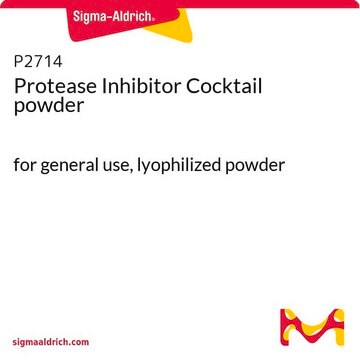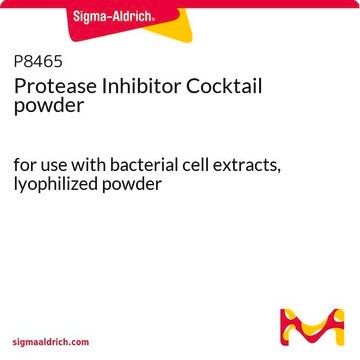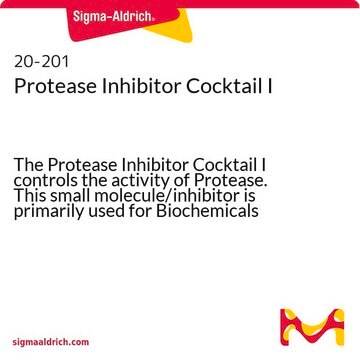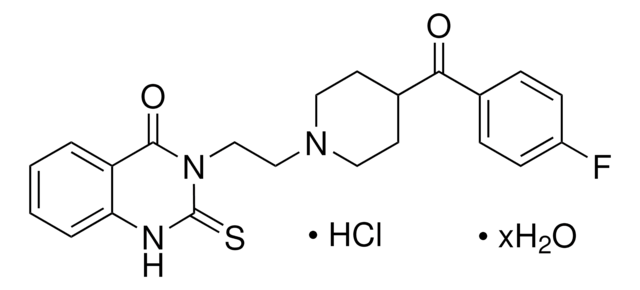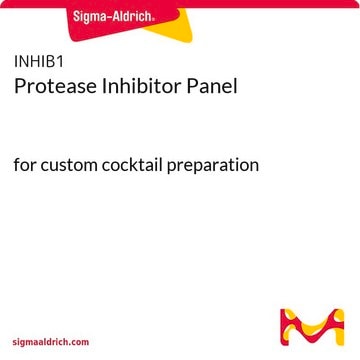SRE0055
Protease Inhibitor Cocktail Powder
Reagents designed and manufactured under cGMP controls suitable for use in an IVD application.
Synonyme(s) :
Protease Inhibitor Cocktail powder
Se connecterpour consulter vos tarifs contractuels et ceux de votre entreprise/organisme
About This Item
Code UNSPSC :
12352200
Nomenclature NACRES :
NA.32
Produits recommandés
Source biologique
bovine lung
yeast
Forme
lyophilized powder
Température de stockage
−20°C
Vous recherchez des produits similaires ? Visite Guide de comparaison des produits
Spécificité
Inhibits serine, cysteine, and metallo-proteases.
Application
Optimized and tested for general use.
Protease inhibitor cocktail powder has been used in immunoblotting and immunoprecipitation.
Protease inhibitor cocktail powder has been used in immunoblotting and immunoprecipitation.
Actions biochimiques/physiologiques
This mixture contains individual components, including AEBSF at 2 mM, Aprotinin at 0.3 μM, Bestatin at 116 μM, E-64 at 14 μM, Leupeptin at 1 μM and EDTA at 1 mM. Each component has specific inhibitory properties.
AEBSF and Aprotinin act to inhibit serine proteases, including trypsin, chymotrypsin, and plasmin amongst others. Bestatin inhibits aminpeptidases. E-64 acts against cystein proteases. EDTA is an inhibitor of metalloproteases. Leupeptin acts against both serine and cystein proteases.
Protease helps to break down proteins into soluble peptides and amino acids.
AEBSF and Aprotinin act to inhibit serine proteases, including trypsin, chymotrypsin, and plasmin amongst others. Bestatin inhibits aminpeptidases. E-64 acts against cystein proteases. EDTA is an inhibitor of metalloproteases. Leupeptin acts against both serine and cystein proteases.
Protease helps to break down proteins into soluble peptides and amino acids.
Composants
1 bottle in serum bottle
Components
AEBSF
Aprotinin
Bestatin
E-64
EDTA
Leupeptin
AEBSF
Aprotinin
Bestatin
E-64
EDTA
Leupeptin
Quantité
One bottle makes 100 mL of cocktail, which are sufficient to the inhibition of proteases present in approximately 20 gram of cell extract.
Not all extracts contain the same levels of endogenous enzymes, and it may be necessary to adjust the volume of cocktail required.
Not all extracts contain the same levels of endogenous enzymes, and it may be necessary to adjust the volume of cocktail required.
Notes préparatoires
This product is supplied as a lyophilized powder. One bottle prepares 100 mL of a cocktail solution.
Mention d'avertissement
Warning
Mentions de danger
Conseils de prudence
Classification des risques
Eye Irrit. 2 - Skin Irrit. 2
Code de la classe de stockage
11 - Combustible Solids
Classe de danger pour l'eau (WGK)
WGK 3
Point d'éclair (°F)
Not applicable
Point d'éclair (°C)
Not applicable
Faites votre choix parmi les versions les plus récentes :
Déjà en possession de ce produit ?
Retrouvez la documentation relative aux produits que vous avez récemment achetés dans la Bibliothèque de documents.
Les clients ont également consulté
Farhan Younas et al.
Biochimica et biophysica acta. Biomembranes, 1860(8), 1544-1553 (2018-05-23)
Legionella pneumophila is an aerobic and nonspore-forming pathogenic Gram-negative bacterium of the genus Legionella. It is the causative agent of Legionnaires' disease, also known as Legionellosis. The hosts of this organism are diverse, ranging from simple water borne protozoans such
Amina E Essawy et al.
PeerJ, 9, e11930-e11930 (2021-08-27)
Bisphenol A (BPA) is an endocrine disruptor to which humans are often subjected during daily life. This study aimed to investigate the ameliorative effect of astragaloside IV (ASIV) or saponins extracted from Astragalus spinosus (A. spinosus) against DNA damage and
Xianzhang Zeng et al.
Microbiome, 11(1), 204-204 (2023-09-12)
Aging is a significant risk factor for ischemic stroke and worsens its outcome. However, the mechanisms for this worsened neurological outcome with aging are not clearly defined. Old C57BL/6J male mice (18 to 20 months old) had a poorer neurological
Biology for the IB Diploma: Standard and Higher Level (2001)
Ahmed S Al-Shami et al.
Molecular and cellular biochemistry (2024-06-28)
Bisphenol A (BPA), a common endocrine-disrupting chemical, is found in a wide range of home plastics. Early-life BPA exposure has been linked to neurodevelopmental disorders; however, the link between neuroinflammation, pyroptosis, and the development of psychiatric disorders is rarely studied.
Notre équipe de scientifiques dispose d'une expérience dans tous les secteurs de la recherche, notamment en sciences de la vie, science des matériaux, synthèse chimique, chromatographie, analyse et dans de nombreux autres domaines..
Contacter notre Service technique
